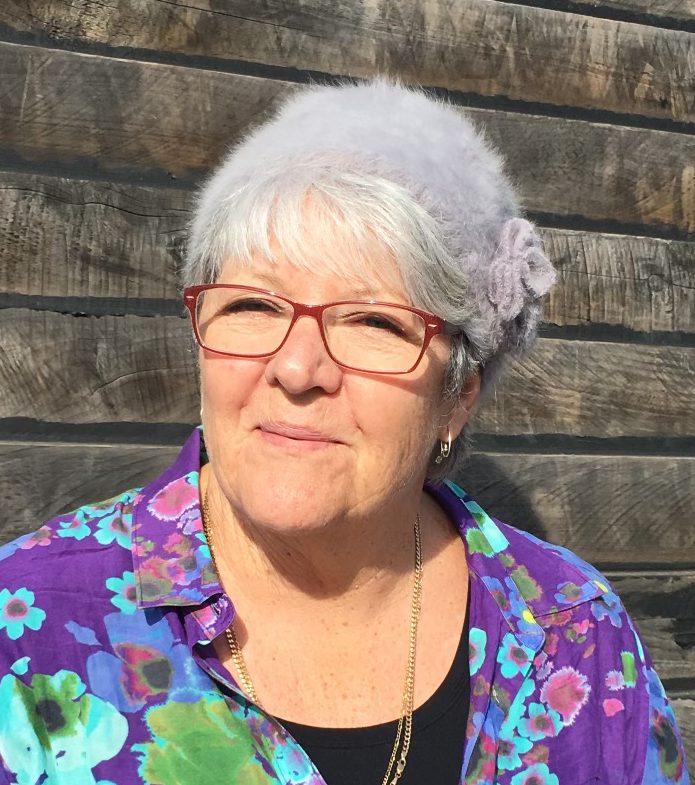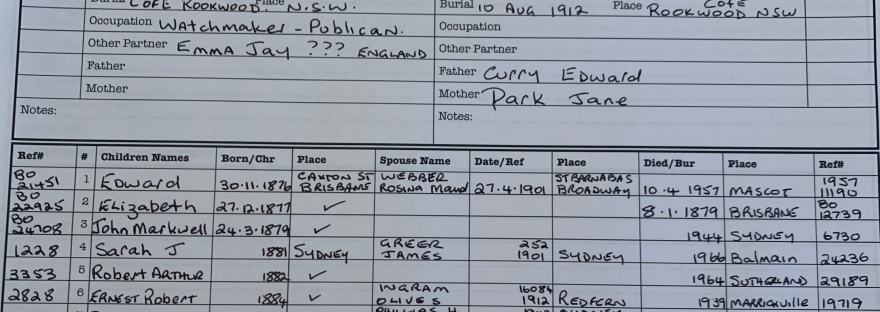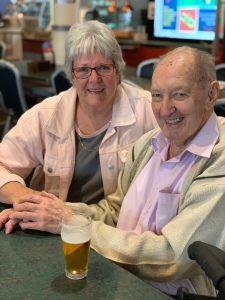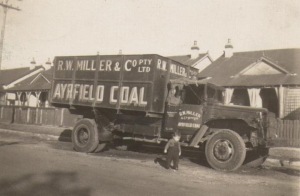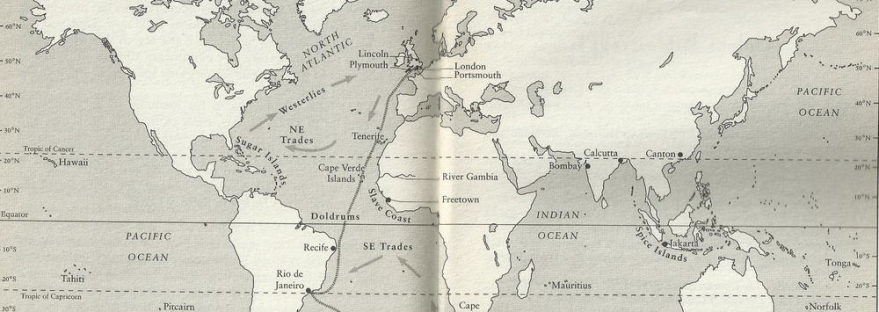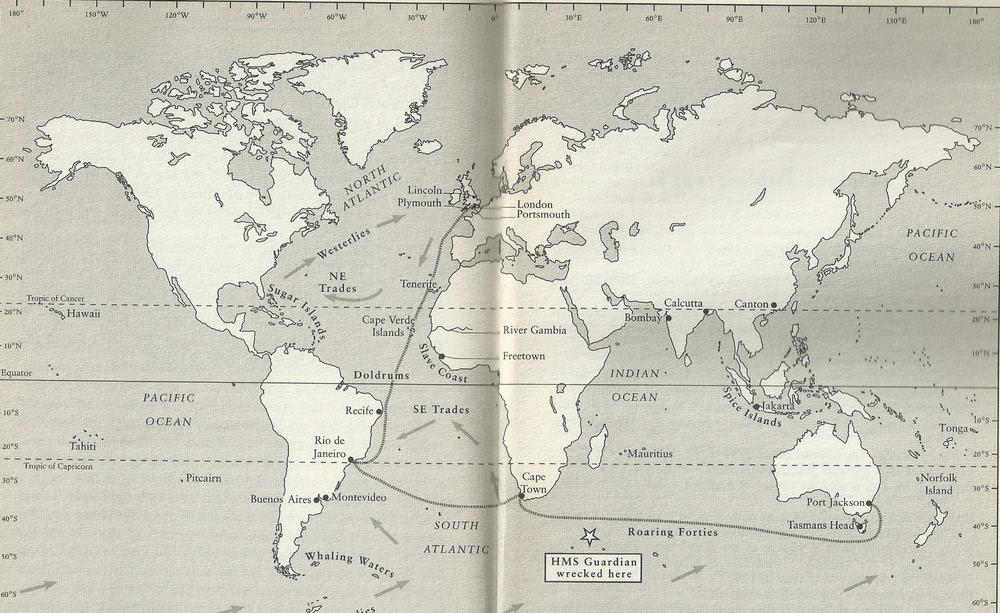1. Florence Grace PARKER
2. Gordon Charles PARKER
3. A Bit About Me.
Florence Grace PARKER
6 December 1901 – 13 November 1957
Written by M Hope 2020
Florrie was my maternal grandmother’s sister. She was 6 years older than my grandmother, Maggie. Florence was born at Mount McDonald, Neville, New South Wales.
Later in life, around the 1940s, my grandmother and Florrie use to meet in town (Sydney) regularly and have lunch and catch up on the family events. Over time, due to illness, the meetings became further and further apart. Then one day a friend stopped my Nan in the street to give her condolences on the passing of her sister Flo. Sadly Flo’s family never contacted anyone to advise of her passing.
After hearing this story it inspired my curiosity about Flo and her family. I recall family members describing her as a well-dressed lady with make-up always applied and smelling of her favourite perfume. I got the impression that she also liked to have a little tipple.
Flo married Bertie James Adolphus Fuller one Monday in October 1917 at the local church in Leadville. New South Wales. Bertie was 25 years old and Flo was 16 and pregnant. The second week in February 1918 Flo gave birth to a son, Frederick. Sadly, he only lived for 3 weeks. This must have been devastating for them both. Twelve months later, on 22 March 1919, Florrie gave birth to a daughter, Rita. In November 1921 another baby arrived. A boy, Herbert. By now Florrie was just 19 years old and had given birth to three babies.
Florrie left the matrimonial home on 19 December 1922. Thirteen days after she turned twenty-one. She didn’t take the children with her, according to the divorce papers.
An affidavit that Bertie signed in 1936 stated that his daughter, Rita, was 17 years old and his son, Herbert was 14 years old. Herbert was living with Bertie’s parents at Mudgee at that time, he paid ten shillings per week to support his son. Nothing was mentioned about Rita, so it is presumed she was self-sufficient. Bertie also stated that he had not had contact with Florrie since she left the matrimonial home in 1922.
Bertie was filing for divorce as he had a liaison with a young girl who was twenty years old and was now with a child. He wanted to marry her. (Bertie was now 32 years old.)
As a young boy, Bertie spent some time on the “Soboran” ship. This ship was for young boys who were from dysfunctional homes and or were troublesome themselves.
The following article was published in the National Advocate (Bathurst, NSW: 1889-1954), Wednesday 5 August 1908, page 1:
A boy named Bertie Fuller absconded from the Sobraon football party at
Bemboka a few days ago. He was subsequently arrested and placed in the
Bega lockup, but he has since escaped from there and is still at large.
Fuller made a former bid for liberty some time ago. On that occasion, he
swam ashore from the Sabraon and was not caught until he had walked 150 miles.
Through my research, I found Florrie, in 1930, living in the Redfern/East Sydney/Surry Hills areas. Her daughter, Rita, must have made contact with her as they lived in the same area. Rita married and had a couple of children. The electoral rolls tell the story of Rita and her husband living separate lives. Rita did not have the privilege of being a stay at home mum as entries in the Electoral rolls state she was a cleaner.
Florrie met Charles Maurice Hurford. He was previously married and had three adult children. His wife, Elizabeth died in 1938. Charles & Florrie cemented their relationship in 1951 when they married.
Six years later, on 30 November 1957, Florrie had a heart attack. She suffered chronic bronchitis and had cirrhosis liver. The Eastern Suburbs Memorial Park’s (Botany Cemetery) register states she was cremated and her ashes were placed in Garden E10, position 13. After many years of searching for a plaque, to no avail, I made enquiries at the cemetery office. They advised me that her ashes only were placed in that position. A plague was never organised.
Florrie’s daughter, Rita, died at her mother’s residence, 139 Goodlett St, Surry Hills on 14 December 1968. Her death certificate stated she died from the effects of burns accidentally received at the time and place when a lounge chair in which she was sleeping apparently caught fire from a lighted cigarette. Inquest – Sydney 14 Mar 1969.
Bertie Fuller died in 1946 leaving behind his wife and young child.
Charles Maurice Hurford died in 1969 and is buried alongside his first wife Elizabeth, at Rookwood Cemetery.
Bless you, all. I hope Florrie and Maggie have once again reunited.
As a family researcher, I become attached to some ancestors I have researched. The more information I unearth about a person, the more I feel connected to them. Florence Grace Parker/Fuller/Hurford is one of those ancestors. Maybe one day we will connect.
Charles Gordon PARKER
Charles Gordon PARKER 1900-1938
Charles PARKER was the fourth son and seventh child to Thomas PARKER and Jane WILLIAMS. He is my grandmother’s brother, my great uncle. I never met Charlies. Actually, I didn’t even know of him until I began my family research. As usual, I wanted to find out as much information I could on my maternal grandmother’s family. They were so interesting and every turn I made I seemed to unearth another story of another ancestor.
In 2019 I received my Diploma of Family History from University of Tasmania. During the Writing Family History unit I had to write a story about an ancestor. I chose Charlie because I had recently found information about his death. He married, but did not have any children. Therefore, Charlie may not be known by any living person today. Charlie needs recognition, so here is the story I wrote about Charles Gordon PARKER born 11 June 1900 at Carcoar, NSW, married Mary Veronica DOHERTY on 15 December 1920 at the NSW Registry Office in Sydney. Sadly, his wife died 15 October 1938 at Kogarah Hospital, Sydney and Charlie died forty four days later on 28 November 1938.
He Couldn’t See the Forest for the Trees!
By Margaret Hope 2018
As Charley shoulders hunched and his head slumped, he began sobbing as he watched his wife slowly succumb to a lifeless existence. He wanted to hold her hand forever. How could he live without her?
He didn’t know how long he had been by her side when a nurse came and took his wife’s cold hand from his grip when he heard a soft, compassionate voice say “Mr Parker, I am so sorry, but we have to take her now. Can I get you a cup of tea?” He bent down to kiss his wife on the forehead, stroked her blonde hair, knowing that this would be his final touch, he sobbed uncontrollably. The nurse gently took his elbow and ushered him into another room. He doesn’t remember how long he was alone, but his thoughts were interrupted when the nurse returned with a cup of tea. “I don’t know what to do now! My life will be so empty without her; it was just us, no babies, just us. What do I do now?” “Go home and rest Mr Parker, and in the morning, you need to go and see the Undertaker and organise her funeral” replied the nurse.
As he sauntered through the hospital corridors, his mind filled with memories of how they lived for one another, how they snuggled like a pair of spoons in bed at night. How they consulted one another about every plan. Their life was a duet! What was he going to do?
Sleep evaded him as he tossed and turned, wondering where he was going to find the money to bury his beloved Vonnie! They lived from week to week, and he hadn’t been to work for a fortnight as he didn’t want to leave Vonnie’s bedside while she fought incidious cancer in her cervix.
He must have eventually slept. He was dreaming that Vonnie was knocking at the front door when his sleep was interrupted. He threw the sheets from his body as he leapt out of bed yelling, “Alright, alright, I’m coming!” As he opened the door, he saw his landlord standing there. “I’m here to collect the rent Charley, you’re two weeks behind, and I can’t let it go any longer. You’ll have to find another place, I’m afraid”.
“Please, just give me a couple of more days. Vonnie passed away yesterday, and I have to organise her funeral today. I’ll have a cheque for you next week”. The landlord’s head dropped as he gave Charley his condolences but told him he would be back next week to pick up the rent money.
Closing the door, he walked back into the bedroom as he scratched his head. He was in such a dilemma as to how he was going to get out of this financial mess. Where could he get the money for the funeral, let alone the rent?
He found the chequebook and although he knew the bank balance was almost nil, he decided to write a cheque for the funeral and worry about where the cash would come from after he buried his wife.
Vonnie’s funeral was just a blur, the sickly scent of flowers made him feel ill. It was an occasion when Charley just wanted to curl up like a baby and sleep forever. He was lost and couldn’t think logically.
Two weeks after the landlord was rapping on the front door once again. Charley gave him a cheque for rent owed but said he didn’t have any more money to pay rent in advance. The landlord told him to find other accommodation and gave him five days to get out!
The following day Charley answered a rap on the door. There stood the Undertaker. “The bank dishonoured your cheque, Charley. You’ll need to find cash to finalise the account.” He broke down and told the Undertaker that he didn’t have the money. He said, “I don’t have a job I don’t have a wife, and I don’t have any money”. The Undertaker replied “Life goes on Charlie. You must honour your debts, I’ll see you in court”.
A few days later, the Sherriff arrived at his door with a summons to appear before the Court. The Undertaker wanted his money!
Charley just wanted to run away in the hope that he may escape this horrible life. He couldn’t see his way out. He had no money, no food. Life was not worth living!
On Monday 28th November 1938, the day before he was due in court, it was raining, and the southerly wind was blowing when Charley boarded the train late in the afternoon at Sutherland railway station. He watched the rain beating on the window, getting harder and harder as the train gathered speed. His destination was unknown. His body was numb, his heart was broken, and he was hoping this train may lead him out of his black hole.
The next day, the evening paper announced that when the official at Kogarah Court called Charley’s name, a Detective informed the Magistrate he had been killed at Central Railway Station when he fell under a train. The court papers were marked ‘defendant deceased’.
Charley left a suicide note in the band of his hat saying that he could not go on. He loved his wife and their people, and he knew they loved him, he left whatever money he had to his brother, Arthur. The last words he wrote were ‘don’t forget me’!

Note: His wife had an older sister named Eliza. I have no idea who Ron was.
Another article published in Truth (Sydney, NSW : 1894 – 1954), Sunday 11 December 1938, page 15
LEFT MESSAGE IN HIS HAT
Suicide Worried Over Money
LEAVING a farewell message in the band of his hat, Charles Gordon Parker, 38, laborer, committed suicide by diving in front of a train on November 28 last. He was almost decapitated. The City Coroner. Mr. E. T. Oram, was told that Parker had been worried over money matters, and was to have appeared at Kogarah Court on the day following his death to answer a charge of forgery. Parker’s last message read: ‘I want to say goodbye to all. Tell them I never touched that, book. Goodbye. Eliza. I love you. I loved all her people and I know they loved me, I can-not go on. Give Arthur all my money Arthur, get drunk on the day. son. don’t forget me.— Charley Parker.’
May you rest in peace Charley Parker along with your beloved Vonnie.
After reading this story, I hope you won’t forget Charley.
A Bit About Me

I find it difficult to write about myself. I much prefer to delve into my ancestors lives. But here I will try to give an insight to my past and perhaps you will get to know me.
When I was born my family lived with my maternal grandparents, three uncles, and my brother and parents in a two bedroom terrace house at Botany. Yes, that’s nine people in a two bedroom terrace. My grandparents were in the main bedroom. Mum, Dad, brother and I were in the second bedroom. The front veranda was closed in and two of my uncles slept there and the lounge room was partitioned off with a curtain, where my other uncle’s bed was located. We later moved into my paternal aunt’s house in the Mascot area. Some time later my parents found an old house in Robey St Mascot, just down the road from my paternal grandparents house. We lived there for a few years until we moved to Matraville. The house my parents purchased was just across the road from my fathers’ workplace. He was a truck driver and worked for a man call Clarrie Dunn.
A few years later our family grew with the addition of twin sisters. I remember those years when they were babies and Mum would be waiting for me to get home from school so I could feed one of the twins their afternoon beverage.
Tragedy hit our household just after Christmas the year the twins were born. One of the twins was diagnosed with meningitis and passed away. Not long after that Mum and Dad separated and Dad eventually moved to Queensland with his work. Mum had to go to work and our baby sister was cared for by my grandparents.
My father was a very strict parent. I learned from a very early age that when he said “NO” he meant it. But, when Mum said “no” she could be swayed to retract the negative. So, with Dad no longer at home, my brother and I became a little troublesome. Neither of us liked high school and with mum at work it made it easy to have a day or two away from school.
We both left school at 14 years and 10 months old. My brother worked for the local council and I was in and out of jobs like a blow fly. Mainly factory processing work.


My paternal grandfather bought me a portable typewriter and I went to night school to learn to type. I eventually got a job as a telephonist in the days of the Sylvester Switchboard. From there each job I applied for I moved a little up the ladder until I was recognised as a Bookkeeper.
Back in 1981 when my maternal grandmother passed away, I began my research. It was often pushed under the bed collecting dust from time to time. When we moved down to the south coast I joined the local family history society. The first AGM I attended I found myself on the committee. I began to come out of my shell as I became the Research Officer, then the Librarian and eventually the President. This chapter of my life has been the most rewarding, socially.
I have not mentioned my children here as my family history research delves into those who have passed, respecting relatives who are still living and honouring those who have left us. I have found uncle and aunts who never married or had children so I feel it is my duty to also preserve their lives as they were once loved family members to our direct ancestors.

